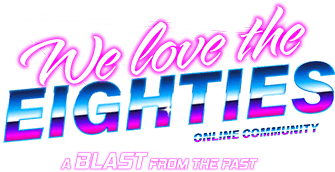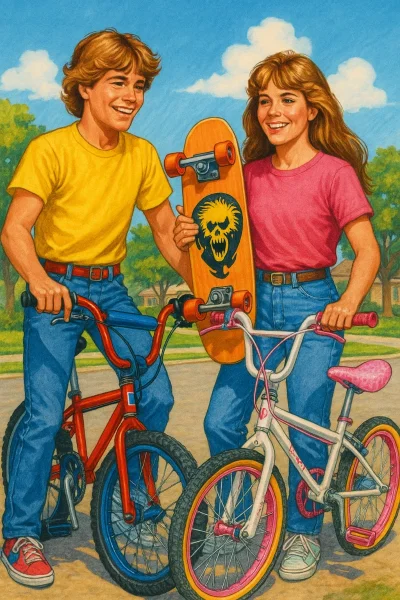Mrs. Eighties
80s Member
- Jun 26, 2023
- 61
- 39
In the 1980s, your bike or skateboard was more than just a way to get around. It was your symbol of freedom. Before smartphones and GPS, we roamed the neighborhood with windblown hair and scraped knees, creating our own paths with every ride. Whether it was a neon colored BMX bike or a beat up board with peeling grip tape, what you rode showed everyone exactly who you were.
I still remember my first bike like it was yesterday. It was bright pink with handlebar streamers and a banana seat that sparkled in the sun. I felt like the coolest kid on the block. Every evening, a bunch of us, mostly boys but they always let me ride too, would race down the street, jumping curbs and chasing each other to the stop sign like it was the finish line of a championship. No helmets, no phones, just the sound of pedals turning, kids laughing, and the occasional dog barking somewhere in the distance.
BMX bikes were everything back then. They had thick tires, stunt pegs, and bold designs that made you feel unstoppable. If you had a Mongoose, a Redline, or a GT, people noticed. These bikes were not just for getting places. They were for stunts, races, and bragging rights.
Skateboards had their own kind of attitude. The kids who rode them always seemed cooler, like they knew something the rest of us did not. The boards were wide and heavy, often worn down from years of use. The bottoms had wild graphics with flames, skulls, or screaming faces that looked straight out of a rock album. I was never great at skating, but I tried. I remember falling in front of a group of boys and acting like it did not hurt. It did, but I was proud of that scrape on my elbow. It meant I had the guts to try.
Skateboarding started to boom thanks to magazines, skate videos, and pro skaters who looked like they lived at the arcade. Brands like Powell Peralta and Vision Street Wear were suddenly on shirts and shoes. Half pipes were built in backyards and empty pools turned into practice spots for kids with real nerve. One of the best parts of this era was how creative we all were. We added beads to our spokes, taped up our handlebars with bright colors, put reflectors everywhere, and covered everything in stickers. We were not copying anyone. We made our bikes and boards our own.
Girls were out there too. We may not have been in the ads, but we were riding hard, getting dirty, and laughing just as loud. The pavement did not care if you were a boy or girl. If you could ride, you were in. It was a different time. No one was filming every move or checking in every hour. We left the house after breakfast and rode until the streetlights came on. The sidewalk was our highway. The cul de sac was our arena.
In 1984, the movie Rad introduced BMX racing to a wider audience. It did not do well in theaters, but it found a second life on VHS and became a favorite for kids who loved their bikes. Many still consider it one of the most iconic underground films of the decade. The 1980s taught us that adventure did not need fancy gear or perfect tricks. It lived in the thrill of a downhill sprint, the excitement of a new trick, or just being out with your friends. Riding in style meant riding free. That feeling has never gone out of fashion.
I still remember my first bike like it was yesterday. It was bright pink with handlebar streamers and a banana seat that sparkled in the sun. I felt like the coolest kid on the block. Every evening, a bunch of us, mostly boys but they always let me ride too, would race down the street, jumping curbs and chasing each other to the stop sign like it was the finish line of a championship. No helmets, no phones, just the sound of pedals turning, kids laughing, and the occasional dog barking somewhere in the distance.
BMX bikes were everything back then. They had thick tires, stunt pegs, and bold designs that made you feel unstoppable. If you had a Mongoose, a Redline, or a GT, people noticed. These bikes were not just for getting places. They were for stunts, races, and bragging rights.
Skateboards had their own kind of attitude. The kids who rode them always seemed cooler, like they knew something the rest of us did not. The boards were wide and heavy, often worn down from years of use. The bottoms had wild graphics with flames, skulls, or screaming faces that looked straight out of a rock album. I was never great at skating, but I tried. I remember falling in front of a group of boys and acting like it did not hurt. It did, but I was proud of that scrape on my elbow. It meant I had the guts to try.
Skateboarding started to boom thanks to magazines, skate videos, and pro skaters who looked like they lived at the arcade. Brands like Powell Peralta and Vision Street Wear were suddenly on shirts and shoes. Half pipes were built in backyards and empty pools turned into practice spots for kids with real nerve. One of the best parts of this era was how creative we all were. We added beads to our spokes, taped up our handlebars with bright colors, put reflectors everywhere, and covered everything in stickers. We were not copying anyone. We made our bikes and boards our own.
Girls were out there too. We may not have been in the ads, but we were riding hard, getting dirty, and laughing just as loud. The pavement did not care if you were a boy or girl. If you could ride, you were in. It was a different time. No one was filming every move or checking in every hour. We left the house after breakfast and rode until the streetlights came on. The sidewalk was our highway. The cul de sac was our arena.
In 1984, the movie Rad introduced BMX racing to a wider audience. It did not do well in theaters, but it found a second life on VHS and became a favorite for kids who loved their bikes. Many still consider it one of the most iconic underground films of the decade. The 1980s taught us that adventure did not need fancy gear or perfect tricks. It lived in the thrill of a downhill sprint, the excitement of a new trick, or just being out with your friends. Riding in style meant riding free. That feeling has never gone out of fashion.











